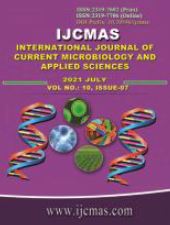


 National Academy of Agricultural Sciences (NAAS)
National Academy of Agricultural Sciences (NAAS)

|
PRINT ISSN : 2319-7692
Online ISSN : 2319-7706 Issues : 12 per year Publisher : Excellent Publishers Email : editorijcmas@gmail.com / submit@ijcmas.com Editor-in-chief: Dr.M.Prakash Index Copernicus ICV 2018: 95.39 NAAS RATING 2020: 5.38 |
Mushrooms are a significant food crop for large population throughout the globe. The main edible mushroom is the button mushroom (Agaricus bisporus), a perfect example of economical food production which is manufactured on a specific manure delivered from farming residue materials. In mushroom cultivation successive microbial community consists of a variety of microorganisms including bacteria, actinomycetes and fungi at first breakdown the straw to form lignin humus complex and discharge the gases, and then metabolise the cellulose and hemicellulose into compost microbial biomass. This decayed straw along with microbial biomass turns into an organic and inorganic nutrient source for the mushroom mycelium and these micoflora play a main role during the different stages of composting and resist the growth of other competitor in the crop production. In most farms, seasonal cultivation of this mushroom is being practiced, but they are vulnerable to a spread of viral, bacterial and fungal diseases. Standardization of compost composition and composting processes, disinfection of casing soil, cultural practices, and sanitation has significantly reduced the prevalence of those moulds in mushroom crops.
 |
 |
 |
 |
 |